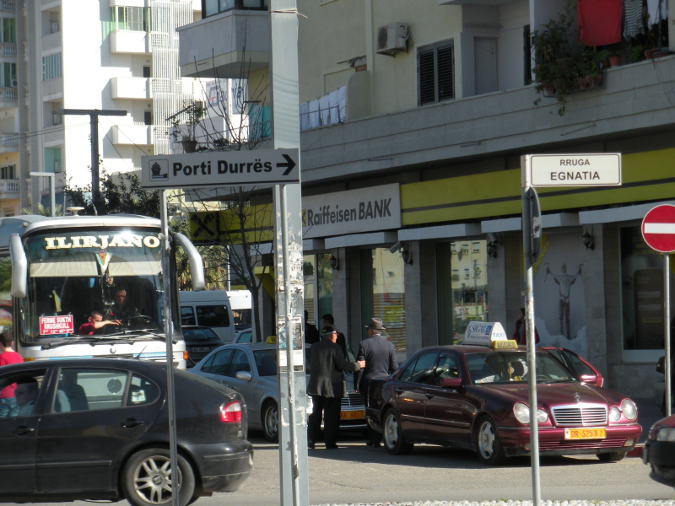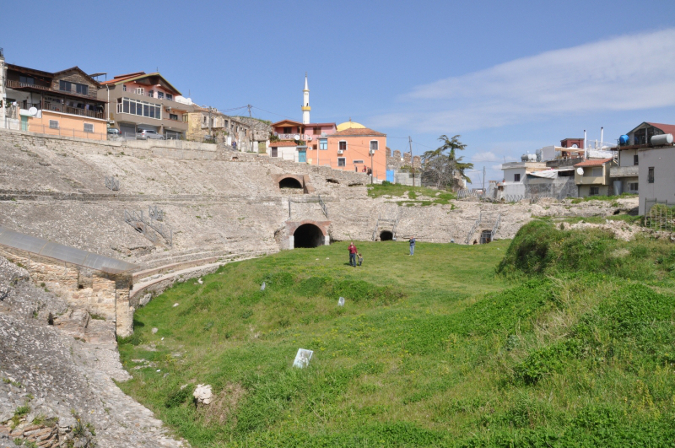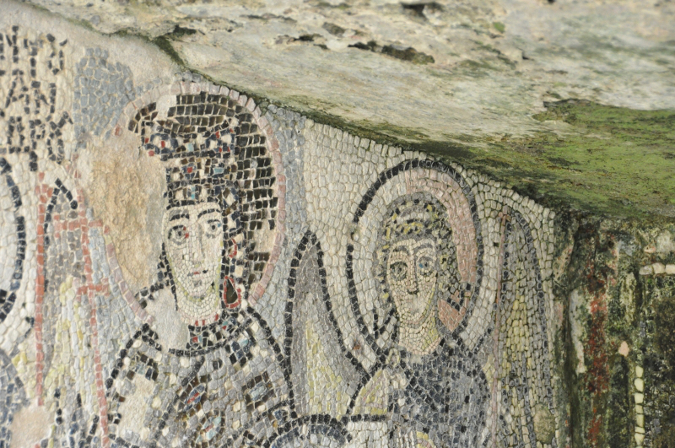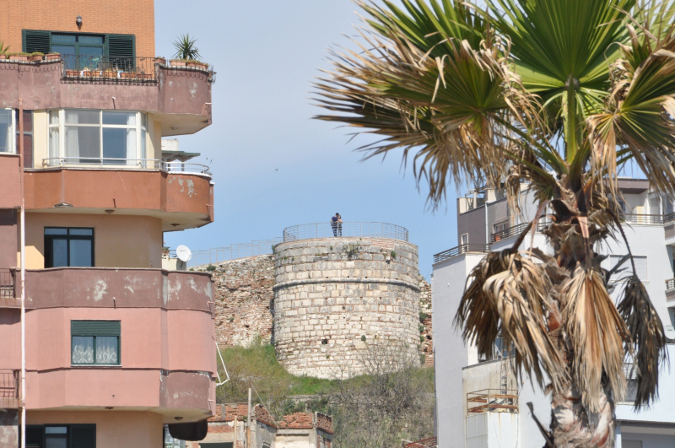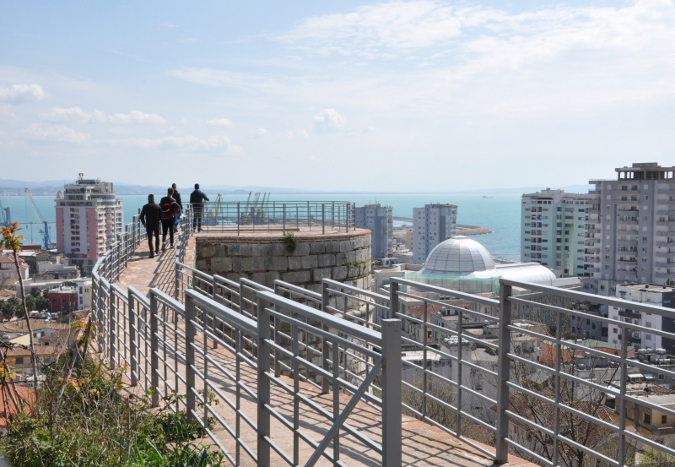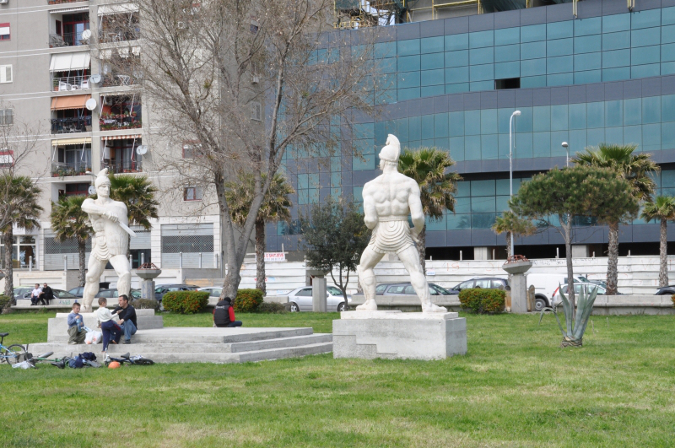Durres, the Albanian port
A walk through the streets of old Durres, where past and present are inextricably entwined
A huge, double-headed bronze eagle rising from the centre of the roundabout shows me I’ve reached Shesh Shqiponjë (Eagle Square), the coach terminal. Following a few days in the Albanian capital, Tirana, I’m curious to see another, more ancient city with a rich history, that is Durrës.
People arriving by plane in the “Country of the Eagles” (Shqipëria, the official name for Albania) land not far from Tirana and, as they drop down, see a broad green valley, bounded to the east by high, steep mountains – the first outposts of the complex Balkan chains – and to the west by pleasant, rolling hills. This is why the Albanian capital, though hardly forty kilometres from the coast, has an almost continental feeling and climate.
One’s first visit to Albania, however, should begin in the bay of Durres, which has always been the true entrance to the country – a port on the Adriatic sea, or “port in Illyria”, as it was called during its long, fascinating history. As the coach approaches the sea, its seats taken up by students and commuters rather than tourists, in my mind I retrace what I expect from this visit to Durres on the basis of my reading: a Roman Amphitheatre, an Archaeological Museum and a Byzantine Forum.
However the difference between a virtual journey and the real one is, above all, the surprise; and my first, small surprise happens when, on arrival, leaving the coach and crossing the first street, I read a white road sign at the junction saying Rruga Egnatia: the ancient Roman road linking Italy and the West with the Orient which continues via Thessaloniki through to Constantinople. For those who over the centuries disembarked on the quays of this still busy port (85% of the country’s imports and exports pass through here), it was a continuation of Via Appia Antica across the Adriatic. For me, born where the Via Appia starts, at the gates of Ancient Rome, it’s almost like extending my teenage walks on long summer afternoons on the other side of the sea.
Durres (known in antiquity as Epidamnus or Dyrhacchium) was one of two starting points for this vital artery of the Empire; the other was Apollonia, some sixty kilometres to the south. But, while today Apollonia is just an archaeological site, Durres, as I see and hear finally around me, still teems untidily with life and commercial activity. Not for nothing was it once called in jest the “Adriatic tavern”, a definition given it by the poet Catullus – famed for his “thousand kisses” to Lesbia – one who knew about the good life. And the Roman playwright Plautus made this the setting for a curious event in which two Sicilian identical twins, separated in their infancy without ever being reunited, meet unbeknownst to each other in the area near the port, thus giving rise to an entertaining “comedy of errors”, the title used by Shakespeare when he recycled the story.
In short, here in Durres numerous travellers, sea-farers and traders from all over, that is the West and the East, encountered each other. Or, sometimes, they parted company. As when Caesar began his decisive duel with Pompey from here – an exhausting game of chess fought by the two armies between the sea and the long promontory parallel to the coast on the crest of which today’s city was founded. Or, again, after Theodosio’s death (395 A.D.), when the Roman Empire split definitively into two parts, the eastern and western, the demarcation line passed just to the north of Durres. Which was the beginning of that separation into two Europes, the East and the West, which quickly became the division between the Orthodox and the Catholic, between the Greek-Eastern-Slav world and the Latin-Western world – a break which efforts are still being made to repair today. Through projects like TransEuropean Corridor 8, for instance, which should link the “heel of Italy” with the Black Sea, its Balkan route starting here at the ancient port of Dyrhacchium. All of this, obviously, only if Europe doesn’t fall to pieces once more, rather like it did at the death of Theodosius.
But, to come back to our crossroads, no-one is really certain that it is the street with this name, jammed with cars I’m trying to get past, that was the course of the ancient Egnatia. One theory is, on the contrary, that, though beginning in the city, it was at a point nearer to the sea where one of the most interesting archaeological remains in Durres is to be found – the Forum or Byzantine “Macellum”. When I get there I find this too was a kind of junction-roundabout, encircled however by columns, most of which even now gleam slim and silent between blocks of flats and offices, right behind the square of the Bashkia (Town Hall), now the “drawing room” of modern Durres.
The town centre lies at the foot of the southern spur of the promontory Durres was built on, with its steep slope exploited by the Romans to build what some held to be the largest amphitheatre in the Balkans, with the major axis of its ellipse being 120 metres. This Albanian “Colosseum” is the first place I visit, following the pavement along the present-day Egnatia then cutting across the Town Hall Square, paved in stone and refined by modern fountains. Unlike other amphitheatres that we are used to in Italy and the remote provinces of the Empire, only part of this one was constructed with a wall, since almost all its northern hemicycle abutted on the rocky incline of the promontory. Today it is a sort of peaceful oasis in the middle of the busy city, easy to visit and open on holidays as was the day on which I arrived. Here too, a surprise: the surrounding houses do not, as they seem to do in old photos, reach right up to its steps, but crown it in quite a pleasant way. The part which has been almost completely lost, however, is its upper circuit on the southern side where it dips towards the sea.
While I explore in the shade the tunnels serving the great Roman edifice, half walled and half dug out of the rock below the ancient stone tiers, I pause to admire the mosaics dating from before the year 1,000 in a small Byzantine church which, making use of the abandoned structure, had been inserted into its imposing ruins. The frontal faces and wide-open eyes of the dignitaries, angels and saints, seem to welcome visitors unperturbed, taking them back to a transcendent, timeless faith. Some tombs of the period show that the site, as was common then in holy places, was also used as a cemetery.
When I get back to the open air of the arena, my attention is drawn to a mighty circular tower rising above the hemicycle, well above the row of houses, topped by railings through which some youngsters dangle their legs while looking at the view. Today is a school holiday and, against the sky, those students on their day off look carefree out in the wind and sun – which finally has begun to shine after my first days spent in continental Tirana.
I suppose that from up there one really dominates the city with a glance, as Aristotle in his Politics stated that a Greek polis worthy of this name should be embraced. This meant not only dominate in a glance – and thus control from the acropolis – the built-up area and the countryside, but also to be able to know personally and directly, given the reduced size of the Greek city-state, all its citizens. Therefore, continued the philosopher, to be better able to discuss with them freely and alternate in power – these were the first forms of self-government in history.
“Embrace with a glance” the ancient Epidaurum, a Greek colony founded between 628 and 624 B.C., proves harder for me than I thought. Even if the tower looked close to the amphitheatre, there is no direct street or stairway. The small houses which have sprung up all over the slopes of the citadel have privatized all access and, only after several fruitless tries, do I find someone to show me the right way: a paved road with a wide bend takes me up to where I have the tower behind me. The passer-by who gives me the information then hands me on to a group of local youths on their way up there, at least that’s what I understand in broken English. The climb is steep, confirming those etymologies that gave it the name Dyrhacchium as connected to the Ancient Greek rhachia, stony, rocky shore, thence “rachis”- a protrusion or backbone. We come to the bend where we turn to approach the edge of the hill top, and there, gaining access to our view point, I realise that the road continues on the other side, directly to another spectacular point on the promontory, the one boasting the elegant Liberty residence built by King Zog, who had to hand over Albania to the Italians in 1939.
The long climb is rewarded when, faithfully following my casual escorts, I reach the top of the coveted tower. At that point the whole city and sweeping gulf on which it was founded are at my feet. My gaze takes in nearly 360° and I am amazed at the beauty before me. The skyscrapers built over the last ten years, in a disorderly manner and expressing bizarre architectural fantasies, fail to hide the extraordinary basis of the ancient foundations. A broad bay on the Adriatic, a safe harbour, an easy-to-defend acropolis and a little fertile countryside around, crossed by a small river. The typical topography of the ancient Hellenic colonies.
But it must be said that the Ancient Greeks did not build on nothing: before them the Illyrians were here. They were a people made up of many tribes (the streets of Durres record their name as well as that of the Taulantii), fierce and warlike but at the same time prepared to merge and trade with the new arrivals who, as often happens with the present refugees, were nearly all male. And present day Albanians are proud to recall that they are not, like their immediate neighbours, Slavs, nor even Greeks, but, more or less directly, Illyrians. In the Archaeological Museum, built near the sea front in 2002 (in Taulanti street, to be precise) marble gravestones with names as symbols on the tombs can be seen. They are all written in Ancient Greek: the Illyrians, like other Balkan peoples, did not have a written language, but the actual names are not at all Greek. So today we can pronounce the same sounds of over two thousand years ago in the various Plator, Eortais, Boiken, Teuta. . .
My young companions now tell me their names too, with that great variety of different ethnic and linguistic origins that one finds today on Albanian identity cards. They have, at last, taken great bottles of beer out of their bags, and they offer me some, proposing an unexpected toast here above the land and sea of Albania, unconsciously paying homage to the affectionate nickname for this town, the Tavern of the Adriatic. They tell me about the surrounding places, the ancient and modern buildings; they show me with pride a vast Albanian flag flapping above a nearby crag and won’t give up until I take its photo. Using expressions more suited to football fans than politics, they tell me they would not support either their neighbouring Serbs nor the Greeks.
Certainly, like their immediate neighbours, Albanians are not lacking in national pride, a pride sometimes bordering on fervent nationalism. Here at Durres, it must not be forgotten, the first Regnum Albaniae was founded in 1272, proclaimed by Charles of Anjou. This event officially produced a name: Arberia (then Albania) which we also find in the name of the language Arbëreshëwhich is still spoken by the “historic” Albanians living in southern Italy for centuries, having come as refugees after the death of Skanderberg, hero of the anti-Ottoman resistance.
I take my leave of my young companions, as they continue their celebrations, and I descend towards the sea via what is left of the Byzantine, then Venetian and finally Ottoman walls. Five-sided turrets alternate with great circular towers at the salient points. It was said that the ancient medieval walls of Durres were so thick and resistant that four armed horsemen, could ride side by side easily on the bastions. Indeed, in this centre of the Adriatic, one of the first Roman emperors of the Eastern Empire was born, one who knew about systems of defence – Anastasius I, who built a wall sixty kilometres long on the Thracian peninsula furthest to the east, in order to protect the imperial capital, Constantinople, from the barbarians.
As I come to the sea front, despite the cold wind from the northwest, I find a more relaxed atmosphere, almost with a holiday feel. Beyond that marine horizon the port of Brindisi is, as ancient geographers wrote, “a thousand stadions” away. It would seem a lot, but, thinking that an ancient “stadion” corresponds to approximately 180-190 metres, the distance a sprinter runs in a few seconds, one understands how so much history passed through here. And these kilometres, seen from above in an aeroplane, really seem just a small jump, a handful of minutes from the heel of Italy, a little east of Brindisi and a little north of the Salento region.
Two hefty warriors in cement fighting a duel on the esplanade, representing who knows which contest in Illyrian history, accommodate on their pedestal a family picnic. Vendors of coloured balloons, kites flying in the air, electric cars for children and many groups of adolescents enjoying the evening stroll on their day off, wander past the cafés and restaurants of the seafront which have dared to put out the first tables for a season about to begin.
Here in Greek Epidaurum, 2,400 years ago, a banal political dispute between aristocrats and democrats – who evidently were not able to “alternate in power” – degenerated, firstly into a civil war, then into respective requests for military assistance to the two mother-countries – Corfu and Corinth. Seeing that neither party prevailed, further help was requested from the respective, even more powerful allies – Athens and Sparta. Thus began a general conflict lasting nearly thirty years, written of in history books as the Peloponnese war. The war which signed the death warrant for Athens and, in essence, the decline of the classical world.
Impressions, memories, past and present accumulate and interlace inextricably while strolling with a light, springtime heart through the streets of Durres.
Featured articles
- Take part in the survey
Durres, the Albanian port
A walk through the streets of old Durres, where past and present are inextricably entwined
A huge, double-headed bronze eagle rising from the centre of the roundabout shows me I’ve reached Shesh Shqiponjë (Eagle Square), the coach terminal. Following a few days in the Albanian capital, Tirana, I’m curious to see another, more ancient city with a rich history, that is Durrës.
People arriving by plane in the “Country of the Eagles” (Shqipëria, the official name for Albania) land not far from Tirana and, as they drop down, see a broad green valley, bounded to the east by high, steep mountains – the first outposts of the complex Balkan chains – and to the west by pleasant, rolling hills. This is why the Albanian capital, though hardly forty kilometres from the coast, has an almost continental feeling and climate.
One’s first visit to Albania, however, should begin in the bay of Durres, which has always been the true entrance to the country – a port on the Adriatic sea, or “port in Illyria”, as it was called during its long, fascinating history. As the coach approaches the sea, its seats taken up by students and commuters rather than tourists, in my mind I retrace what I expect from this visit to Durres on the basis of my reading: a Roman Amphitheatre, an Archaeological Museum and a Byzantine Forum.
However the difference between a virtual journey and the real one is, above all, the surprise; and my first, small surprise happens when, on arrival, leaving the coach and crossing the first street, I read a white road sign at the junction saying Rruga Egnatia: the ancient Roman road linking Italy and the West with the Orient which continues via Thessaloniki through to Constantinople. For those who over the centuries disembarked on the quays of this still busy port (85% of the country’s imports and exports pass through here), it was a continuation of Via Appia Antica across the Adriatic. For me, born where the Via Appia starts, at the gates of Ancient Rome, it’s almost like extending my teenage walks on long summer afternoons on the other side of the sea.
Durres (known in antiquity as Epidamnus or Dyrhacchium) was one of two starting points for this vital artery of the Empire; the other was Apollonia, some sixty kilometres to the south. But, while today Apollonia is just an archaeological site, Durres, as I see and hear finally around me, still teems untidily with life and commercial activity. Not for nothing was it once called in jest the “Adriatic tavern”, a definition given it by the poet Catullus – famed for his “thousand kisses” to Lesbia – one who knew about the good life. And the Roman playwright Plautus made this the setting for a curious event in which two Sicilian identical twins, separated in their infancy without ever being reunited, meet unbeknownst to each other in the area near the port, thus giving rise to an entertaining “comedy of errors”, the title used by Shakespeare when he recycled the story.
In short, here in Durres numerous travellers, sea-farers and traders from all over, that is the West and the East, encountered each other. Or, sometimes, they parted company. As when Caesar began his decisive duel with Pompey from here – an exhausting game of chess fought by the two armies between the sea and the long promontory parallel to the coast on the crest of which today’s city was founded. Or, again, after Theodosio’s death (395 A.D.), when the Roman Empire split definitively into two parts, the eastern and western, the demarcation line passed just to the north of Durres. Which was the beginning of that separation into two Europes, the East and the West, which quickly became the division between the Orthodox and the Catholic, between the Greek-Eastern-Slav world and the Latin-Western world – a break which efforts are still being made to repair today. Through projects like TransEuropean Corridor 8, for instance, which should link the “heel of Italy” with the Black Sea, its Balkan route starting here at the ancient port of Dyrhacchium. All of this, obviously, only if Europe doesn’t fall to pieces once more, rather like it did at the death of Theodosius.
But, to come back to our crossroads, no-one is really certain that it is the street with this name, jammed with cars I’m trying to get past, that was the course of the ancient Egnatia. One theory is, on the contrary, that, though beginning in the city, it was at a point nearer to the sea where one of the most interesting archaeological remains in Durres is to be found – the Forum or Byzantine “Macellum”. When I get there I find this too was a kind of junction-roundabout, encircled however by columns, most of which even now gleam slim and silent between blocks of flats and offices, right behind the square of the Bashkia (Town Hall), now the “drawing room” of modern Durres.
The town centre lies at the foot of the southern spur of the promontory Durres was built on, with its steep slope exploited by the Romans to build what some held to be the largest amphitheatre in the Balkans, with the major axis of its ellipse being 120 metres. This Albanian “Colosseum” is the first place I visit, following the pavement along the present-day Egnatia then cutting across the Town Hall Square, paved in stone and refined by modern fountains. Unlike other amphitheatres that we are used to in Italy and the remote provinces of the Empire, only part of this one was constructed with a wall, since almost all its northern hemicycle abutted on the rocky incline of the promontory. Today it is a sort of peaceful oasis in the middle of the busy city, easy to visit and open on holidays as was the day on which I arrived. Here too, a surprise: the surrounding houses do not, as they seem to do in old photos, reach right up to its steps, but crown it in quite a pleasant way. The part which has been almost completely lost, however, is its upper circuit on the southern side where it dips towards the sea.
While I explore in the shade the tunnels serving the great Roman edifice, half walled and half dug out of the rock below the ancient stone tiers, I pause to admire the mosaics dating from before the year 1,000 in a small Byzantine church which, making use of the abandoned structure, had been inserted into its imposing ruins. The frontal faces and wide-open eyes of the dignitaries, angels and saints, seem to welcome visitors unperturbed, taking them back to a transcendent, timeless faith. Some tombs of the period show that the site, as was common then in holy places, was also used as a cemetery.
When I get back to the open air of the arena, my attention is drawn to a mighty circular tower rising above the hemicycle, well above the row of houses, topped by railings through which some youngsters dangle their legs while looking at the view. Today is a school holiday and, against the sky, those students on their day off look carefree out in the wind and sun – which finally has begun to shine after my first days spent in continental Tirana.
I suppose that from up there one really dominates the city with a glance, as Aristotle in his Politics stated that a Greek polis worthy of this name should be embraced. This meant not only dominate in a glance – and thus control from the acropolis – the built-up area and the countryside, but also to be able to know personally and directly, given the reduced size of the Greek city-state, all its citizens. Therefore, continued the philosopher, to be better able to discuss with them freely and alternate in power – these were the first forms of self-government in history.
“Embrace with a glance” the ancient Epidaurum, a Greek colony founded between 628 and 624 B.C., proves harder for me than I thought. Even if the tower looked close to the amphitheatre, there is no direct street or stairway. The small houses which have sprung up all over the slopes of the citadel have privatized all access and, only after several fruitless tries, do I find someone to show me the right way: a paved road with a wide bend takes me up to where I have the tower behind me. The passer-by who gives me the information then hands me on to a group of local youths on their way up there, at least that’s what I understand in broken English. The climb is steep, confirming those etymologies that gave it the name Dyrhacchium as connected to the Ancient Greek rhachia, stony, rocky shore, thence “rachis”- a protrusion or backbone. We come to the bend where we turn to approach the edge of the hill top, and there, gaining access to our view point, I realise that the road continues on the other side, directly to another spectacular point on the promontory, the one boasting the elegant Liberty residence built by King Zog, who had to hand over Albania to the Italians in 1939.
The long climb is rewarded when, faithfully following my casual escorts, I reach the top of the coveted tower. At that point the whole city and sweeping gulf on which it was founded are at my feet. My gaze takes in nearly 360° and I am amazed at the beauty before me. The skyscrapers built over the last ten years, in a disorderly manner and expressing bizarre architectural fantasies, fail to hide the extraordinary basis of the ancient foundations. A broad bay on the Adriatic, a safe harbour, an easy-to-defend acropolis and a little fertile countryside around, crossed by a small river. The typical topography of the ancient Hellenic colonies.
But it must be said that the Ancient Greeks did not build on nothing: before them the Illyrians were here. They were a people made up of many tribes (the streets of Durres record their name as well as that of the Taulantii), fierce and warlike but at the same time prepared to merge and trade with the new arrivals who, as often happens with the present refugees, were nearly all male. And present day Albanians are proud to recall that they are not, like their immediate neighbours, Slavs, nor even Greeks, but, more or less directly, Illyrians. In the Archaeological Museum, built near the sea front in 2002 (in Taulanti street, to be precise) marble gravestones with names as symbols on the tombs can be seen. They are all written in Ancient Greek: the Illyrians, like other Balkan peoples, did not have a written language, but the actual names are not at all Greek. So today we can pronounce the same sounds of over two thousand years ago in the various Plator, Eortais, Boiken, Teuta. . .
My young companions now tell me their names too, with that great variety of different ethnic and linguistic origins that one finds today on Albanian identity cards. They have, at last, taken great bottles of beer out of their bags, and they offer me some, proposing an unexpected toast here above the land and sea of Albania, unconsciously paying homage to the affectionate nickname for this town, the Tavern of the Adriatic. They tell me about the surrounding places, the ancient and modern buildings; they show me with pride a vast Albanian flag flapping above a nearby crag and won’t give up until I take its photo. Using expressions more suited to football fans than politics, they tell me they would not support either their neighbouring Serbs nor the Greeks.
Certainly, like their immediate neighbours, Albanians are not lacking in national pride, a pride sometimes bordering on fervent nationalism. Here at Durres, it must not be forgotten, the first Regnum Albaniae was founded in 1272, proclaimed by Charles of Anjou. This event officially produced a name: Arberia (then Albania) which we also find in the name of the language Arbëreshëwhich is still spoken by the “historic” Albanians living in southern Italy for centuries, having come as refugees after the death of Skanderberg, hero of the anti-Ottoman resistance.
I take my leave of my young companions, as they continue their celebrations, and I descend towards the sea via what is left of the Byzantine, then Venetian and finally Ottoman walls. Five-sided turrets alternate with great circular towers at the salient points. It was said that the ancient medieval walls of Durres were so thick and resistant that four armed horsemen, could ride side by side easily on the bastions. Indeed, in this centre of the Adriatic, one of the first Roman emperors of the Eastern Empire was born, one who knew about systems of defence – Anastasius I, who built a wall sixty kilometres long on the Thracian peninsula furthest to the east, in order to protect the imperial capital, Constantinople, from the barbarians.
As I come to the sea front, despite the cold wind from the northwest, I find a more relaxed atmosphere, almost with a holiday feel. Beyond that marine horizon the port of Brindisi is, as ancient geographers wrote, “a thousand stadions” away. It would seem a lot, but, thinking that an ancient “stadion” corresponds to approximately 180-190 metres, the distance a sprinter runs in a few seconds, one understands how so much history passed through here. And these kilometres, seen from above in an aeroplane, really seem just a small jump, a handful of minutes from the heel of Italy, a little east of Brindisi and a little north of the Salento region.
Two hefty warriors in cement fighting a duel on the esplanade, representing who knows which contest in Illyrian history, accommodate on their pedestal a family picnic. Vendors of coloured balloons, kites flying in the air, electric cars for children and many groups of adolescents enjoying the evening stroll on their day off, wander past the cafés and restaurants of the seafront which have dared to put out the first tables for a season about to begin.
Here in Greek Epidaurum, 2,400 years ago, a banal political dispute between aristocrats and democrats – who evidently were not able to “alternate in power” – degenerated, firstly into a civil war, then into respective requests for military assistance to the two mother-countries – Corfu and Corinth. Seeing that neither party prevailed, further help was requested from the respective, even more powerful allies – Athens and Sparta. Thus began a general conflict lasting nearly thirty years, written of in history books as the Peloponnese war. The war which signed the death warrant for Athens and, in essence, the decline of the classical world.
Impressions, memories, past and present accumulate and interlace inextricably while strolling with a light, springtime heart through the streets of Durres.

